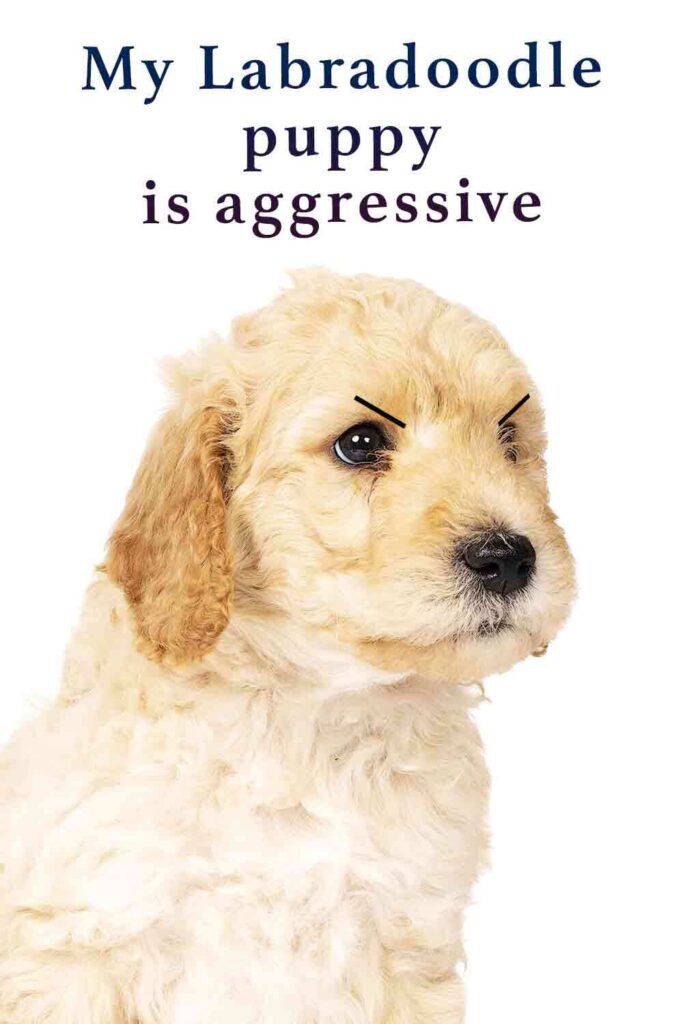My Labradoodle puppy is aggressive! Any puppy, including Labradoodle puppies can show aggressive behavior.
But, there is a difference between normal puppy biting or playing and actual aggression. All puppies will bite to an extent when they are teething and learning how to play with you.
They may growl, snarl, and even draw blood. But, this is very different to resource guarding, a high prey drive, and fearful aggression.
Are Labradoodles an Aggressive Breed?
Labradoodles are quickly growing in popularity. They’re a mix between a purebred Labrador Retriever and a Standard Poodle – two breeds known for their friendly natures and strong family bonds.
Generally, Labradoodles are not known to be aggressive dogs. Their tendency to aggression will usually fall somewhere between that of their parents, if not a little lower.
However, it will depend on the level of socialization and training they receive when they are younger.
Studies into purebred dog aggression have shown that the Labrador scores consistently below average, and Poodles scored slightly above average.
Both parent breeds also have a history as sporting dogs. So, they can exhibit a high pretty drive towards small animals and children. Teaching kids how to interact properly with dogs can help with this.
For most Labradoodle owners, aggression won’t be a problem. But, it’s common for puppies to display aggressive behaviors.
My Labradoodle Puppy is Aggressive
You might think that your Labradoodle puppy is aggressive if they commonly exhibit the following behaviors:
- Biting
- Growling
- Snarling
- Overly rough play
- Chasing
- Chewing or gnawing everything they can
- Jumping up to bite
- Drawing blood when they bite
Most Labradoodle puppies are sweet and cuddly members of the family. But, there are instances where puppies can exhibit aggressive behaviors.
What many people don’t realise is that a lot of the behaviors listed above are actually completely normal. They aren’t necessarily a sign of an aggressive dog.

Normal Puppy Behaviors
Any puppy can display aggressive behaviors. But, it’s important that owners can distinguish between normal puppy phases and aggressive behaviors that are something to worry about.
Normal puppy behaviors include:
- Mouthing or teething
- Chewing, nipping, and gnawing
- Growling or snarling during play
- Biting during play
- Biting or chasing children
In the first few weeks, or even months, after your Labradoodle comes home, it may seem like they’ve been replaced by a tiny fluffy crocodile.
Why Do Puppies Do This?
All puppies go through a teething phase where they will chew, nip, gnaw and bite anything that comes within reach.
It can also be a common issue when puppies interact with small children or other household pets.
When puppies play with their littermates or other pets, it’s common and normal for them to be a bit rough. Often, dog on dog play can emulate fighting, and it’s easy to confuse the two.
The best way to tell if your puppy is playing fairly is to watch his body language.
Puppies that jump, pounce, leap and have an otherwise loose body are playing. A playful puppy will be wagging their tail loosely from side to side and will take turns being the dominant or the subservient of the game. This is healthy play.
Children and Puppies
Children often fall victim to rougher play and puppy biting because children tend to play more animatedly with puppies.
They use their arms and legs, flail, shriek and run, and all of these behaviors can amp a puppy up and make them play rougher or bite harder.
Again, this is normal puppy behavior that will ease over time with proper training and socialization.
But, until then you can reduce it by teaching your children how to play with your Labradoodle in a calm way.
Make sure that you have a safe and secure puppy zone where you can take the puppy to calm down if play gets too rough or excitable. This time away from younger children will be beneficial for your puppy, especially when it is getting a little too worked up.
How to Prevent Puppy Biting
Puppy biting is completely normal, but that doesn’t mean it isn’t also frustrating, painful, and stressful.
Try to redirect your puppy’s gnawing teeth onto teething toys rather than your arms. Wear tight clothing, and nothing that seems like it would be fun to bite at or tear.
Treat your Labradoodle when they are calm, or when they play with you and don’t bite.
Try to ignore your puppy completely when they bite you. Reacting with a squeal or shout can encourage biting, and responding with aggression can lead to fearfulness in your Labradoodle.
It’s important that you can remove yourself from your puppy when biting gets too much. This doesn’t mean abandon your puppy all day. But, make sure that you’re also prioritising your own mental health!
Using a puppy safe zone is a great way to remove yourself when things get too excitable.
You won’t be able to prevent puppy biting altogether. But, it is a phase that will pass. Most owners don’t even realise when it stops!
Real Aggression in Puppies
All puppies have the potential to grow up to be aggressive. Labradoodle dogs are no exception.
Chewing, teething, nipping and even biting can all be normal behaviors in young puppies. But, there are a few red flags of aggression that owners should watch out for, even at an early age.
It’s important to manage these behavioral problems whilst your puppy is young.
A Labradoodle that grows up without proper training and socialization is more likely to be an aggressive older dog, or an older dog that bites.
Resource Guarding
Resource guarding is when your puppy actively guards anything of value. The most common things puppies feel the need to guard include:
- Their food
- Toys
- Bedding
- Their favorite family member
A puppy who is resource guarding will often tense up when someone or something comes too close to what the puppy views as his.
He will often growl and show his teeth and may even bark, lunge or snap in an effort to ward off the intruding person, object or animal.
An Unusually High Prey Drive
The Labradoodle is a mix of two purebred hunting dogs, so it isn’t unusual that your puppy might exhibit a prey drive.
But, some Labradoodles may show an unusually high prey drive that will need to be monitored and carefully controlled.
If your Labradoodle chases anything that moves and aggressively bites it once he catches it, your pup may have this problem.
Labradoodle puppies going into home with other pets must be socialized well and introduced to the other animals slowly to ensure no fights.
Stranger Danger
Pay attention to how your puppy reacts when strangers enter your home or when he passes people he does not know on the street.
If he barks, lunges, growls or appears otherwise uneasy, it’s important to begin working towards resolving these behaviors.
Puppies may also exhibit stranger danger like behaviors towards members of the household. This could include certain genders or builds that make your puppy uncomfortable.
Dog-Directed Aggression
Dog-directed aggression is one of the more common forms of puppy aggression and should not be taken lightly.
Watch your puppy for signs of dog-directed aggression. Do they tense up, launch, growl or bark at passing dogs on the street?
We should note that an excited puppy is not the same as an aggressive puppy and it’s very common for puppies to get excited when they see other dogs.
Loose bodied puppies who are wagging their tails and jumping happily when passing other dogs are simply trying to say hello.
Unwillingness to be Pet or Touched
Most puppies want your attention and affection. But if your puppy begins growling or nipping when you pet him or pick him up, it’s time to look into managing these behaviors.
It is not normal for puppies to have this reaction every time you interact with them. Especially if it is paired with a tense body, cowering, trying to hide from you, or other signs of fearful aggression.
Obvious Signs of Fear
Puppies who are very fearful or standoffish are more likely to grow up and develop anxiety and fear-based aggressive tendencies.
Fear often comes from a negative experience with a child or person and can lead to lifelong issues for a dog.
You can help combat these problematic behaviors by properly socializing your Labradoodle puppy during his youth to ensure he grows up happy, healthy and well-rounded.
How to Prevent Labradoodle Aggression
It’s never too early to begin working with your Labradoodle puppy on training and socialization. A well trained and properly socialized Labradoodle puppy is much more likely to grow up well-mannered.
Work to get your whole family on board when it comes to training and socialization. Ensure your puppy is introduced to as many new sights, sounds, people, places and experiences as possible to help him become more adaptable.
Some great places to socialize your puppy include:
- Schoolyards during busy pick up or drop off times
- Different types of transport, including buses and trains
- The beach
- Dog parks
- Shopping centers or supermarkets (only those that allow dogs)
- Car parks
- Pubs or bars
- Sports matches
Socialization should happen ideally before 12 weeks of age. But, you may have to carry your Labradoodle whilst socializing them, as they cannot go on the ground until they’ve had all necessary vaccinations.
It’s also important to monitor young children around your Labradoodle puppy to ensure everyone is getting along safely and happily, and make sure you speak with older children about the appropriate ways to handle and interact with the family dog.
When to Call a Behaviorist
Signs of true puppy aggression cannot and should not be ignored. If you feel your puppy is exhibiting worrying behaviors, you should work on managing these behaviors right away.
The younger you begin working with your puppy on combating aggression, the more likely you are to reduce and diminish these problems.
Of course, some problematic or aggressive behaviors cannot be dealt with on your own. There could also be underlying issues with your puppy that require professional help. When in doubt, don’t hesitate to reach out to your veterinarian regarding aggressive behaviors.
You also have the option of contacting a canine behaviorist who can further assist you in managing Labradoodle aggression during puppyhood. And remember, the quicker you work with your puppy to manage problematic behaviors and aggression, the better off you and your puppy will be.
A behaviorist will be able to help you manage and prevent problems like resource guarding and other types of aggression.
My Labradoodle Puppy is Aggressive!
Have you had problems with an aggressive Labradoodle puppy before? Or are you just trying to get through that painful teething phase?
Let us know your experiences with your own Labradoodle puppy in the comments below.
References and Resources
- Dunbar, I. ‘What’s Important to Know Right Away’, Before & After Getting Your Puppy: The Positive Approach to Raising a Happy, Healthy & Well-Behaved Dog (2004)
- Farrell, L. (et al), ‘The Challenges of Pedigree Dog Health: Approaches to Combating Inherited Disease’, Canine Genetics and Epidemiology (2015)
- O’Neill, D. ‘Progress in Purebred Dog Health Since the Bateson Report of 2010’, Vet Record (2014)
- Shouldice, V. (et al), ‘Expression of Behavioral Traits in Goldendoodles and Labradoodles’, Animals (2019)
- Duffy, D. (et al), ‘Breed Differences in Canine Aggression’, Applied Animal Behavior Science (2008)

